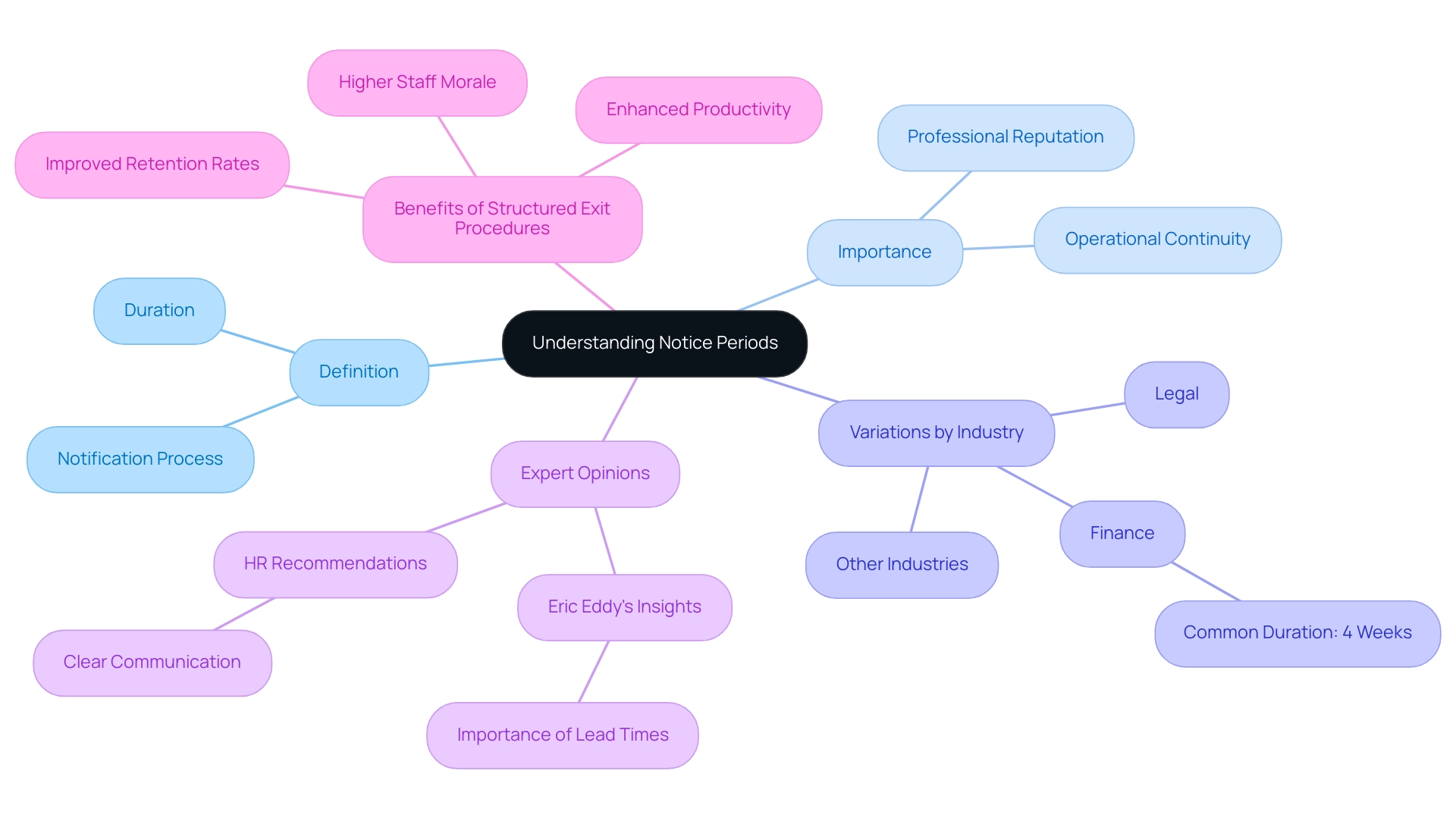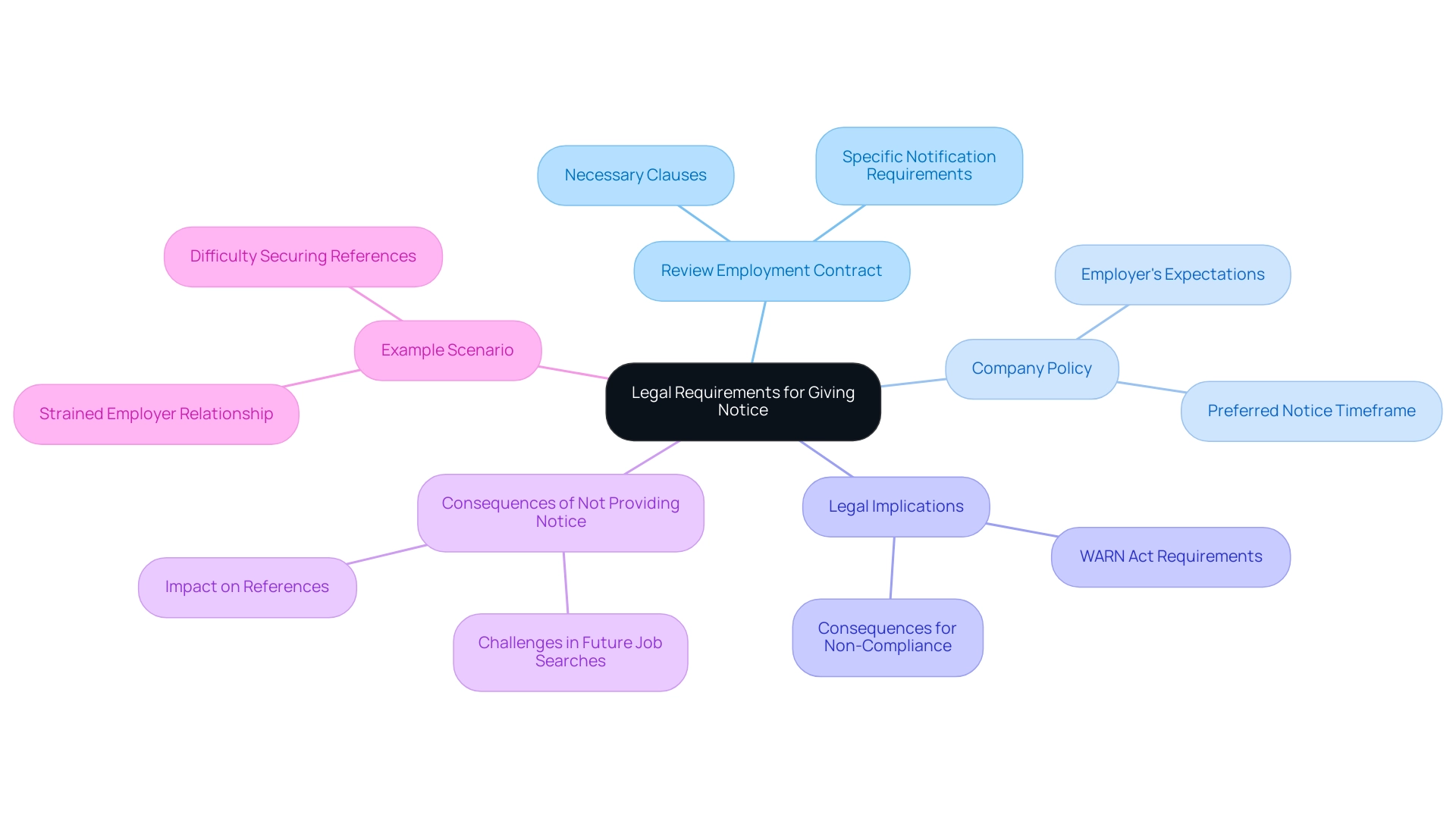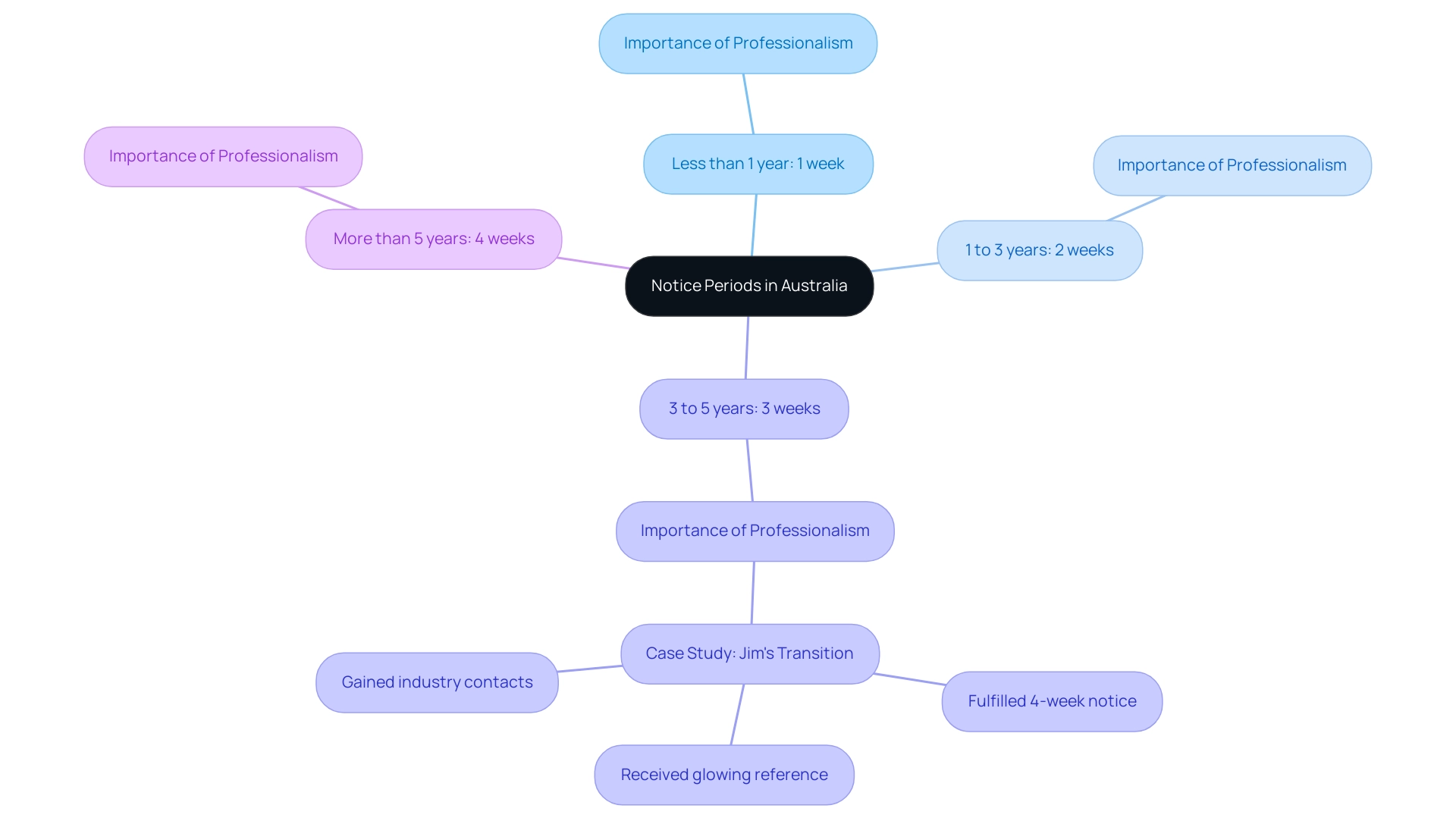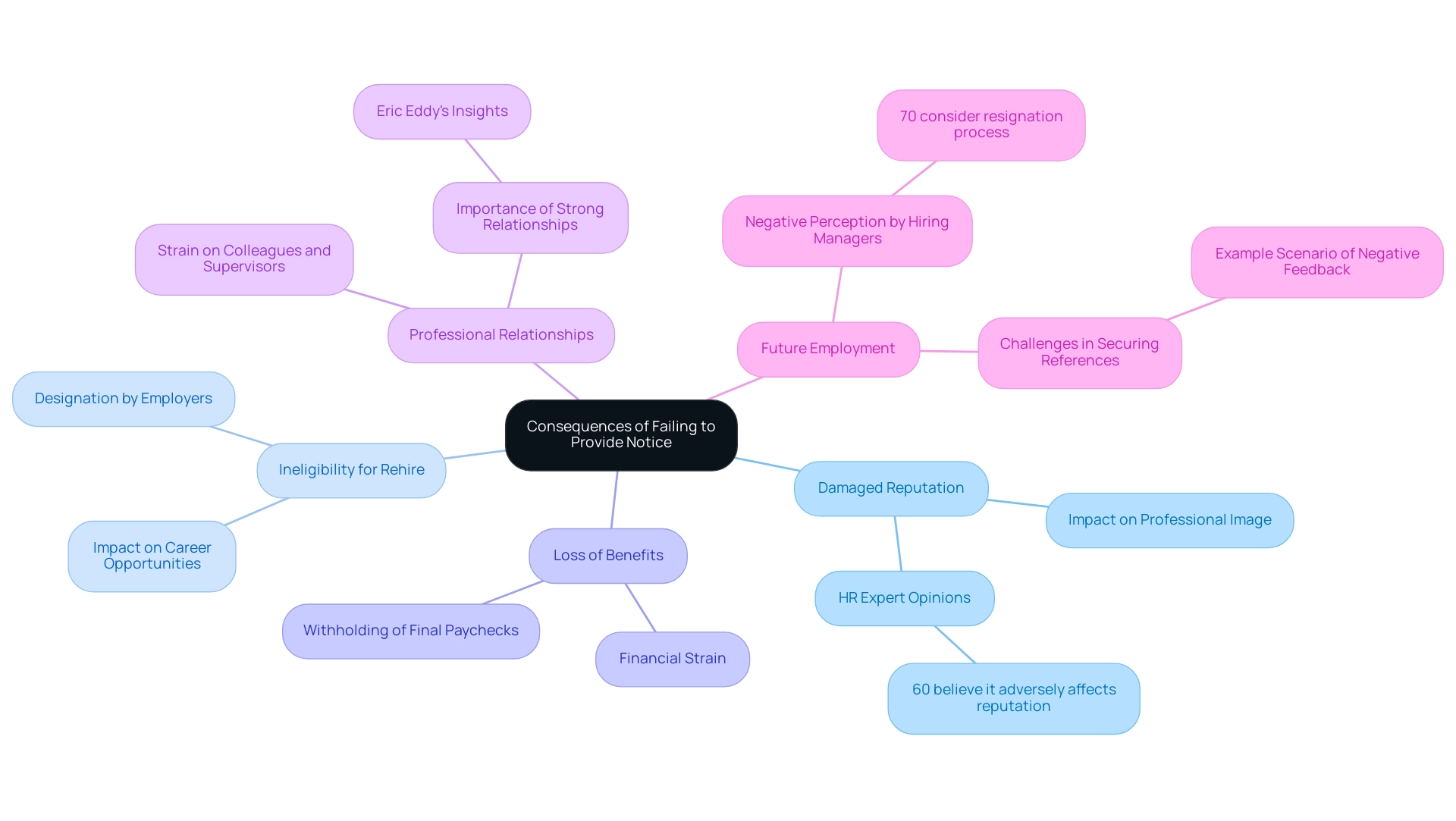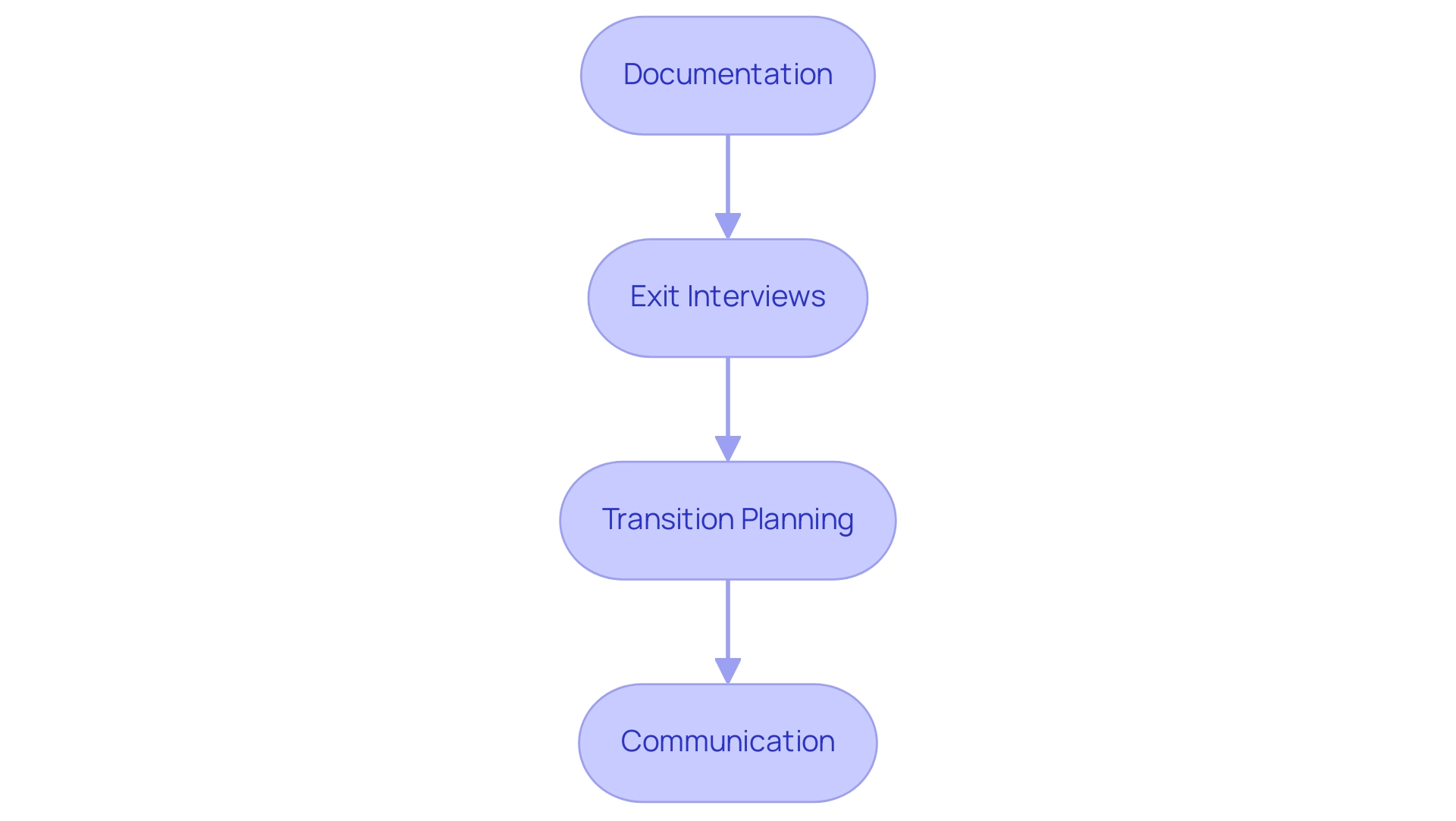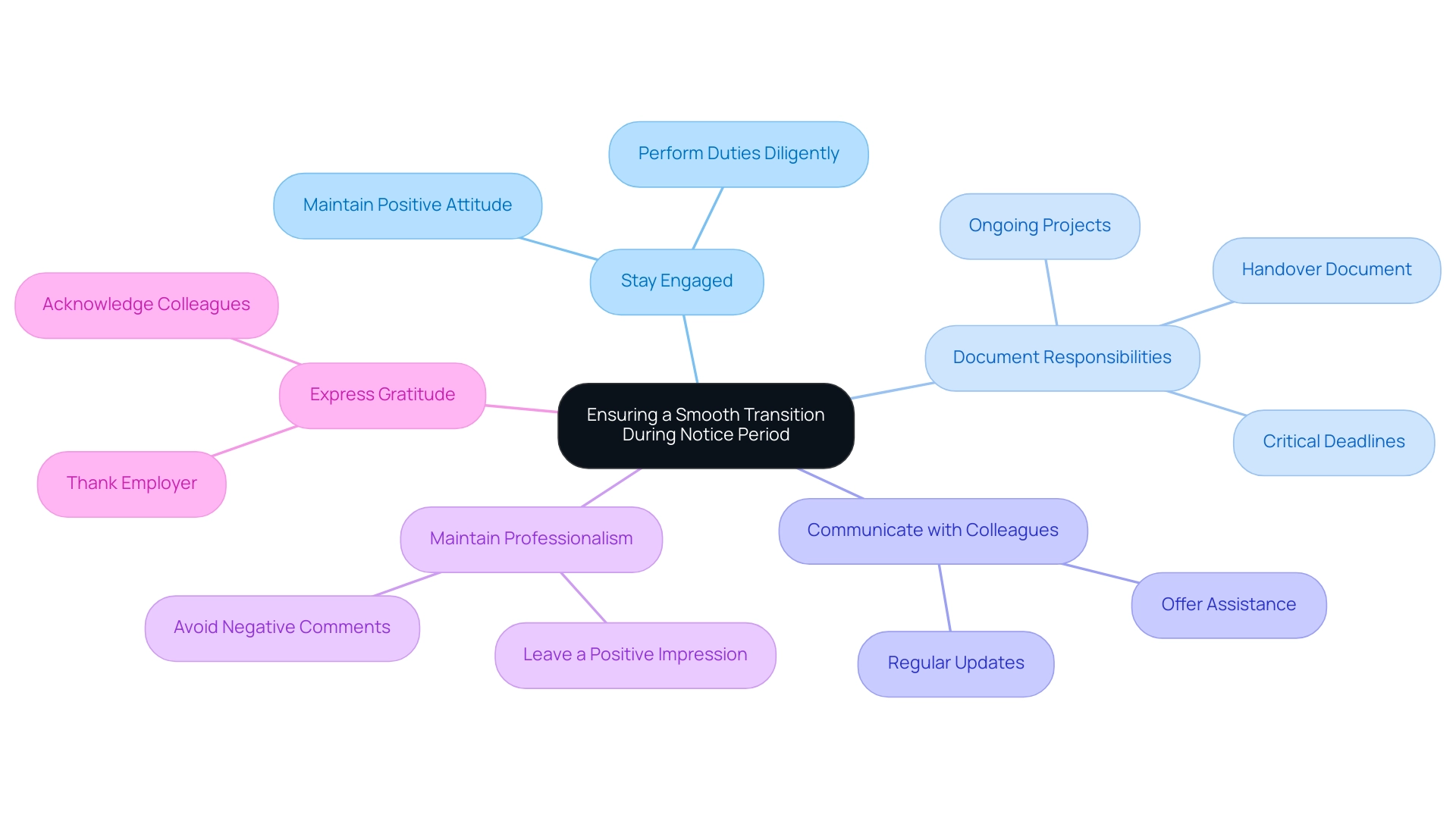Overview
The article “How to Give a Notice at Work: A Comprehensive Guide for Employees” underscores the critical importance of providing a notice period when resigning from a job, detailing best practices for executing this process effectively. Adhering to established notice periods is vital, as it not only helps maintain professional relationships and secures future job references but also ensures operational continuity for employers. This is further illustrated through the article’s thorough exploration of:
- Legal requirements
- The potential consequences of failing to provide notice
- Strategic recommendations for facilitating a smooth transition
Key Highlights:
- A notice period is the time an employee must continue working after resigning, typically around two weeks, but can vary based on company policies and local laws.
- Advance notice allows employers to find replacements and helps employees leave on good terms, preserving their professional reputation.
- In the U.S., while two weeks is standard, specific contractual obligations may exist; failing to adhere to these can lead to negative repercussions.
- Australian notice periods are determined by length of service, ranging from one week for less than a year to four weeks for more than five years.
- Not providing adequate notice can damage an employee’s reputation, make them ineligible for rehire, and lead to loss of benefits.
- HR plays a crucial role in managing resignations, including documenting processes, conducting exit interviews, and planning transitions.
- Best practices for resigning include preparing a resignation letter, scheduling a meeting with supervisors, and offering assistance during the transition.
- Maintaining professionalism during the notice period enhances an employee’s reputation and future job prospects while ensuring operational continuity for the employer.
Introduction
In the intricate landscape of professional transitions, the nuances of notice periods stand out as a critical consideration for both employees and employers. A notice period, often dismissed as a mere formality, serves as an essential bridge between resignation and the next chapter of one’s career. It facilitates a seamless handover of responsibilities and plays a vital role in preserving professional relationships and reputations.
As workplace dynamics continue to evolve, the importance of adhering to notice period guidelines becomes increasingly evident, impacting everything from operational continuity to future job prospects. Have you considered how a well-managed notice period can influence your career trajectory?
This comprehensive exploration delves into the significance of notice periods, legal considerations, and best practices for resigning professionally, ensuring that individuals navigate their career transitions with confidence and poise.
Understanding Notice Periods: Definition and Importance
A notification timeframe is a critical aspect of the resignation process, defining the duration a worker must continue their role after understanding how to give notice at work. Typically, this advance notice is around two weeks; however, variations can arise based on company policies, employment contracts, or local regulations. This timeframe is essential for several reasons: it grants employers the necessary time to identify and onboard a suitable replacement while allowing employees to wrap up their current responsibilities, ensuring a seamless transition.
Mastering the process of giving notice at work is vital for preserving professional relationships and ensuring operational continuity. In 2025, statistics suggest that 65% of employers will prioritize skills and practical experience over formal education. This shift underscores the importance of leaving a favorable impression during transitions. Effectively managing the notification timeframe can significantly impact an employee’s professional reputation; resigning without adequate warning can lead to operational disruptions and tarnish one’s image.
The duration for notifications varies across industries, with sectors like finance and legal often requiring longer periods due to the complexity of roles and the necessity for thorough handovers. For instance, in the financial sector, a four-week notification period is quite common, illustrating the critical nature of these positions.
Experts emphasize the importance of advance notifications during job transitions. HR professionals advocate for clear communication during this period, particularly regarding how to give notice at work, as it fosters goodwill and can lead to positive references in the future. Eric Eddy, an employer at CPA Resources Global Professionals, highlights that the firm’s ability to swiftly and efficiently provide exceptional candidates is often linked to how well lead times are managed.
Research indicates that organizations prioritizing staff engagement and satisfaction during transitions experience enhanced productivity and commitment from remaining personnel. For example, companies that implement structured exit procedures report higher staff morale and retention rates.
In conclusion, understanding how to give notice at work transcends mere formality; it is an integral part of the resignation process that benefits both the employee and employer. By adhering to established timelines, employees can facilitate a smoother transition, uphold their professional reputation, and contribute positively to their organization’s ongoing success. Furthermore, resources such as those offered by Resume Genius can aid job seekers in navigating their career transitions effectively.
Legal Requirements for Giving Notice: What Employees Need to Know
In the United States, while there is no federal regulation mandating a specific advance announcement, it is widely accepted that providing at least two weeks’ notice is a professional courtesy. Employees must scrutinize their employment contracts and company policies to uncover any specific notification requirements that may apply. Understanding these expectations is crucial; failing to give adequate warning can lead to significant repercussions.
- Review Employment Contract: Employees should investigate their contracts for clauses that specify a necessary advance notice period. This can vary by organization and role, and adhering to these terms is essential for maintaining a positive professional relationship.
- Company Policy: Grasping the employer’s expectations regarding notification periods is vital. Many companies have established policies that detail the preferred advance notice timeframe, aiding in a smooth transition.
- Legal Implications: Neglecting to provide advance notice can carry legal ramifications, particularly concerning employment benefits. For example, under the WARN Act, employers must give 60 days’ notice for mass layoffs or plant closures, highlighting the importance of communication during employment transitions.
The consequences of not providing notice can extend beyond immediate job security. Employees who depart without proper notification may find it challenging to secure references from previous employers, which can impede future job searches. Statistics indicate that a lack of warning can lead to unfavorable references, adversely affecting a person’s employability in a competitive job market.
Example Scenario: Imagine an employee who resigns without prior communication. This choice may strain their relationship with the employer, complicating the process of obtaining a reference. Such challenges can significantly impact their ability to secure new employment, underscoring the importance of adhering to advance notification expectations.
Moreover, as candidates navigate their career paths, it’s essential to remember that accepting the first job offer may not always be the best decision. Just as with departures, understanding the full scope of job offers and their implications can facilitate more informed choices. Taking the time to explore multiple opportunities can unveil roles that align more closely with long-term aspirations and professional development.
In summary, comprehending how to provide notice at work, along with the legal obligations and organizational guidelines pertaining to notification durations, is vital for employees. By considering these factors, individuals can learn how to give notice more effectively, preserving their professional reputation and future opportunities. Additionally, fostering positive relationships during this process is paramount, as evidenced by Boutique Recruiting’s impressive track record of success and numerous satisfied clients and candidates.
As Eric Eddy noted, the firm’s ability to deliver top-notch candidates swiftly and efficiently underscores the importance of professionalism in the recruitment process. This personalized approach to recruitment not only benefits employers but also enhances candidates’ prospects in their future job searches.
State-Specific Notice Periods: A Guide for Australian Employees
In Australia, notification durations are established by the length of a worker’s service, as specified by the Fair Work Ombudsman. The standard notice periods are as follows:
- Less than 1 year: 1 week
- 1 to 3 years: 2 weeks
- 3 to 5 years: 3 weeks
- More than 5 years: 4 weeks
It is essential for employees to refer to the Fair Work Ombudsman or their specific employment contract to confirm the exact requirements applicable to their situation. Understanding how to give notice at work is vital not only for legal compliance but also for maintaining professionalism during the resignation process. This professionalism is underscored by Boutique Recruiting’s impressive track record of success, which highlights the importance of leaving on good terms.
Consider a staff member who has served for three years. This individual is obligated to provide at least two weeks’ warning, in accordance with Australian employment standards. Understanding how to give notice at work reflects well on the staff member and fosters a positive relationship with the employer, which can be beneficial for future references or networking opportunities.
As Eric Eddy from CPA Resources Global Professionals mentions, the capability to present high-quality candidates swiftly and effectively aligns with the requirement for staff to give prompt communication to their employers.
Understanding how to give notice at work and the differences in notification times is essential for employees to manage their departure efficiently while ensuring adherence to Australian regulations. This knowledge empowers them to navigate their resignations while preserving their professional reputation. Furthermore, with benefit expenses for state and local government employees having risen by 4.9 percent, maintaining a professional demeanor during departures can be especially advantageous in a competitive job market.
A relevant case study titled “Leaving on a High Note” illustrates this point well. In this scenario, Jim, who worked for a florist full-time, resigned to pursue his own small business. By agreeing to fulfill his four-week transition, he not only secured continued pay but also received a glowing reference and industry contacts from his employer, enhancing his professional reputation and likely leading to support from potential clients and suppliers in his new venture.
This example reinforces the value of understanding how to give notice at work and the positive outcomes that can arise from professionalism during the resignation process.
Consequences of Failing to Provide Notice: Risks and Repercussions
Failing to provide the required notice when resigning can lead to a range of detrimental consequences that extend beyond immediate job loss.
-
Damaged Reputation: An abrupt departure can significantly tarnish your professional image. In 2025, data suggests that almost 60% of HR experts think that departing without warning adversely affects an individual’s reputation in their field.
-
Ineligibility for Rehire: Employers often designate individuals who resign without prior warning as ineligible for future positions. This can severely limit career opportunities, as many companies maintain internal databases of former staff and their departure circumstances.
-
Loss of Benefits: Some organizations may withhold final paychecks or benefits if appropriate warning is not provided, which can create financial strain during a transitional period.
-
Professional Relationships: Leaving abruptly can strain relationships with colleagues and supervisors, potentially leading to a toxic work environment that affects remaining employees. As Eric Eddy noted, maintaining strong professional relationships is crucial, as it can impact future opportunities and references.
-
Future Employment: Understanding how to give a notice at work is crucial, as a lack of notice can be viewed unfavorably by potential employers during reference checks. In fact, a recent survey revealed that 70% of hiring managers consider a worker’s resignation process when evaluating candidates. This aligns with the broader implications of compliance in professional settings, similar to the reporting period for rejected transactions, which emphasizes the importance of adhering to established protocols.
-
Example Scenario: Consider an employee who resigns without knowing how to give a notice at work. This individual may struggle to secure a reference from their previous employer, which can hinder their job search. A case study from 2025 highlights a candidate who, after leaving abruptly, faced significant challenges in obtaining new employment due to negative feedback from former supervisors.
This situation underscores the significance of upholding professionalism during the departure process to protect future career opportunities. Furthermore, comprehending company culture and particular job requirements, as emphasized in the case study titled ‘Differentiation in the Recruiting Market,’ can significantly influence the departure process and future employment opportunities.
How to Resign Professionally: Steps to Communicate Your Decision
To understand how to give a notice at work professionally, adhere to the following steps:
-
Prepare Your Resignation Letter: Clearly state your last working day and include a concise explanation of your decision. A well-crafted letter of departure can positively influence your employer’s perception, as it reflects professionalism and respect.
-
Schedule a Meeting: Arrange a private meeting with your supervisor to discuss your departure. This face-to-face interaction is crucial for maintaining a positive relationship and demonstrates your commitment to a smooth transition.
-
Communicate Clearly: During the meeting, be direct yet respectful when conveying your decision. For instance, you might say, ‘I have decided to resign from my position, and my last working day will be [date]. I appreciate the opportunities I’ve had here and am willing to assist in the transition.’ Clear communication is essential, particularly in understanding how to give a notice at work, as organizations with high engagement experience 51% less turnover, highlighting the importance of maintaining positive relationships even during departures.
-
Offer Assistance: Express your willingness to help during the transition period. This gesture not only supports your employer but also strengthens your professional reputation.
In 2025, best practices for leaving a job include understanding the effect of your departure on the organization. For instance, senior-level executives can incur replacement expenses exceeding 213%, making it crucial to manage departures carefully. Furthermore, organizations that adjust to evolving workforce requirements through supportive policies and adaptable work arrangements are more likely to keep staff, further highlighting the significance of effective departure communication.
As Eric Eddy noted, the ability to deliver top-notch candidates quickly and efficiently is crucial, underscoring the value of maintaining strong professional relationships, which is essential when learning how to give a notice at work to ensure a professional exit that leaves a lasting positive impression.
The Benefits of a Notice Period: Why It Matters for Everyone
Understanding how to give a notice at work is a crucial aspect of the employment transition process, offering significant advantages for both workers and employers in 2025.
Key Benefits:
-
For Employees: Providing notice allows employees to finalize ongoing projects, maintain professional relationships, and secure valuable references for future job opportunities. This proactive approach not only demonstrates professionalism but also enhances their reputation within the industry by illustrating how to give a notice at work. Research indicates that employees who leave on good terms are more likely to receive positive references, which can be instrumental in securing future positions. Eric Eddy, an employer at CPA Resources Global Professionals, emphasizes the importance of professionalism during resignation, noting the firm’s ability to deliver top-notch candidates quickly and efficiently.
-
For Employers: Notice intervals provide employers the necessary time to identify and onboard a suitable replacement, ensuring a seamless transition of responsibilities. This period is vital for maintaining operational continuity and minimizing disruptions to workflow. Employers benefit from having the opportunity to redistribute tasks and train incoming staff, which can lead to a more stable work environment.
Professionalism and Reputation: Leaving a job on good terms significantly enhances an employee’s professional reputation. Statistics show that 70% of hiring managers consider a candidate’s professionalism when evaluating how to give a notice at work during their resignation in job references. This underscores the importance of maintaining a positive relationship with former employers, as it can directly influence future career opportunities.
Real-World Examples: Consider an employee who demonstrates how to give a notice at work by providing a two-week notice before leaving their position. This individual not only completes their projects but also takes the time to train their successor. As a result, they leave behind a well-prepared team and a positive impression, which can lead to a strong reference for their next role.
In contrast, an abrupt departure without understanding how to give a notice at work can create confusion and resentment, potentially harming the individual’s reputation.
Case Studies: A recent study titled “Preparing for 2025 in Compensation and Benefits” highlighted the benefits of structured notice periods in organizations. Organizations that motivated staff on how to give a notice at work reported a 30% rise in successful transitions, as teams could adapt to changes without major interruptions. This proactive engagement fosters a loyal workforce, ready to tackle future challenges in an evolving job market.
Moreover, the variability of notification durations based on individual employment agreements can result in discrepancies across regions, further highlighting the necessity for clear communication during this process.
In conclusion, notice durations are not merely a formality; they are a strategic element of professional transitions that benefit both workers and employers alike. By learning how to give a notice at work, individuals can enhance their career prospects while contributing to a smoother operational flow for their organizations.
The Role of HR in Resignation Processes: Best Practices and Policies
HR plays a crucial role in overseeing the departure process, which includes advising employees on how to give a notice at work, ensuring that both the organization and the departing individual navigate this transition smoothly. Key responsibilities include:
- Documentation: Properly documenting resignation letters is essential to maintain accurate records and comply with company policies.
- Exit Interviews: Conducting exit interviews is vital for gathering valuable feedback and insights from departing staff. These interviews can uncover underlying issues within the workplace and assist in identifying areas for improvement, ultimately contributing to retention strategies. Considering that 58% of staff mention a lack of appreciation as a reason for departing, understanding these sentiments during exit interviews is crucial for enhancing retention efforts.
- Transition Planning: Collaborating with the departing individual on how to give a notice at work and developing a comprehensive transition plan is essential. This plan should outline the process for handing over responsibilities and ensure that ongoing projects are managed effectively.
Key Responsibilities:
- Communication: Maintaining clear and open communication with the resigning staff member and their team is essential. This promotes a nurturing atmosphere and assists in addressing any issues that may arise during the transition. HR must ensure compliance with all legal requirements and company policies throughout the departure process, including how to give a notice at work, protecting the organization against potential conflicts.
Example Scenario: For instance, HR may arrange an exit interview to discuss the individual’s experiences within the organization. This not only offers insights for enhancing workplace culture but also strengthens the company’s dedication to valuing staff feedback. High turnover rates are associated with a 28% decline in staff morale, emphasizing the importance of effective departure management on overall workplace morale.
Furthermore, as organizations increasingly adopt data-driven performance management, those utilizing analytics are 1.5 times more likely to outperform competitors, underscoring the importance of informed decision-making in HR practices. Additionally, with 98% of organizations using online job training tools, HR can prepare remaining employees for transitions and ensure continuity in training and development during the resignation process.
Ensuring a Smooth Transition: Tips for Your Notice Period
To ensure a smooth transition during your notice duration, consider the following strategies:
- Stay Engaged: Maintain a positive attitude and continue to perform your duties diligently. Engaging with your work not only reflects professionalism but also sets a positive tone for your departure, especially when you understand how to give a notice at work.
- Document Responsibilities: Create a detailed handover document that outlines your tasks, ongoing projects, and any critical deadlines. This documentation will serve as a valuable resource for your successor, ensuring they have a clear understanding of their new responsibilities.
- Communicate with Colleagues: Keep your team informed about your transition. Regular updates can help alleviate any concerns and foster a collaborative environment during your remaining time. Offer assistance where needed to facilitate a seamless handover.
Key Tips:
- Maintain Professionalism: It’s crucial to avoid negative comments about the company or colleagues. Professionalism during this period can leave a lasting positive impression.
- Express Gratitude: Take the time to thank your employer and colleagues for the opportunities and experiences gained during your tenure. Recognizing their support can fortify connections and improve your professional network.
A staff member might arrange a meeting with their team to discuss ongoing projects, clarify any outstanding issues, and ensure a smooth transfer of responsibilities, including discussing how to give a notice at work. This proactive approach not only demonstrates commitment but also reinforces a culture of teamwork and support, which can be beneficial when considering how to give a notice at work. This gap highlights the importance of communication and engagement during transitions.
By actively involving your colleagues in the handover process, you can foster a sense of inclusion and collaboration, which is vital for maintaining morale and productivity. Tackling this gap can result in a more unified team dynamic, particularly during times of change.
Case Studies: Boutique Recruiting exemplifies the significance of personalized service and relationship-building in recruitment. Their meticulous approach to understanding company culture and specific job requirements allows them to deliver candidates who not only meet technical qualifications but also fit well within the organizational environment. This strategy enhances client satisfaction and can serve as a model for ensuring smooth transitions during notice periods.
As noted by Gartner (2019), successful organizations find a balance, emphasizing that clear communication and thoughtful planning are essential in managing transitions effectively.
Conclusion
Understanding the intricacies of notice periods is essential for both employees and employers, as it plays a pivotal role in facilitating smooth transitions within the workplace. A well-managed notice period not only allows employees to leave on good terms but also helps employers maintain operational continuity and preserve team morale. By adhering to established notice period guidelines, employees can secure valuable references and enhance their professional reputation, ultimately impacting their future career prospects positively.
The legal implications surrounding notice periods further underscore the importance of compliance with company policies and employment contracts. Failing to provide adequate notice can lead to damaged relationships, negative references, and even financial repercussions. As demonstrated through various case studies, both parties benefit significantly when notice periods are approached with professionalism and respect.
In an evolving job market, the role of HR in managing resignations cannot be overstated. By implementing best practices and ensuring clear communication, HR can support employees during their transitions while also gathering insights to improve workplace culture. As individuals navigate their career paths, recognizing the significance of notice periods and the steps to resign professionally can lead to more favorable outcomes for all involved.
Ultimately, the awareness and execution of effective notice period strategies not only enrich individual career trajectories but also contribute to the overall health of the organization. Embracing these practices fosters a culture of respect and professionalism, paving the way for future opportunities and successful transitions in the ever-changing landscape of work.
Are you ready to enhance your understanding of notice periods and their impact on your organization? Consider the benefits of adopting a structured approach to resignations that promotes professionalism and respect.
Frequently Asked Questions
What is the typical notification timeframe for resigning from a job?
The typical notification timeframe is around two weeks, but it can vary based on company policies, employment contracts, or local regulations.
Why is the notification timeframe important during the resignation process?
It allows employers time to find and onboard a suitable replacement while enabling employees to wrap up their responsibilities, ensuring a seamless transition.
How does the notification period differ across industries?
Notification periods can vary by industry; for example, sectors like finance and legal often require longer notice periods, with four weeks being common in finance due to the complexity of roles.
What are the potential consequences of not providing adequate notice before resigning?
Failing to provide adequate notice can lead to operational disruptions, a tarnished professional reputation, and difficulty securing references from previous employers.
Are there any legal implications associated with providing notice?
Yes, while there is no federal regulation mandating a specific notice period, neglecting to give advance notice can have legal ramifications, particularly concerning employment benefits.
What should employees review before resigning to understand their notification obligations?
Employees should review their employment contracts for any specific notice requirements and familiarize themselves with their employer’s policies regarding notification periods.
How can effective communication during the resignation process benefit employees?
Clear communication fosters goodwill, which can lead to positive references in the future and enhance the employee’s professional reputation.
What role does employee engagement play during transitions?
Organizations that prioritize staff engagement during transitions experience enhanced productivity and commitment from remaining personnel, leading to higher morale and retention rates.
How can employees ensure a smoother transition when resigning?
By adhering to established notification timelines and maintaining clear communication, employees can facilitate a smoother transition and contribute positively to their organization’s ongoing success.
What resources are available for job seekers navigating career transitions?
Resources such as those offered by Resume Genius can aid job seekers in effectively navigating their career transitions.
